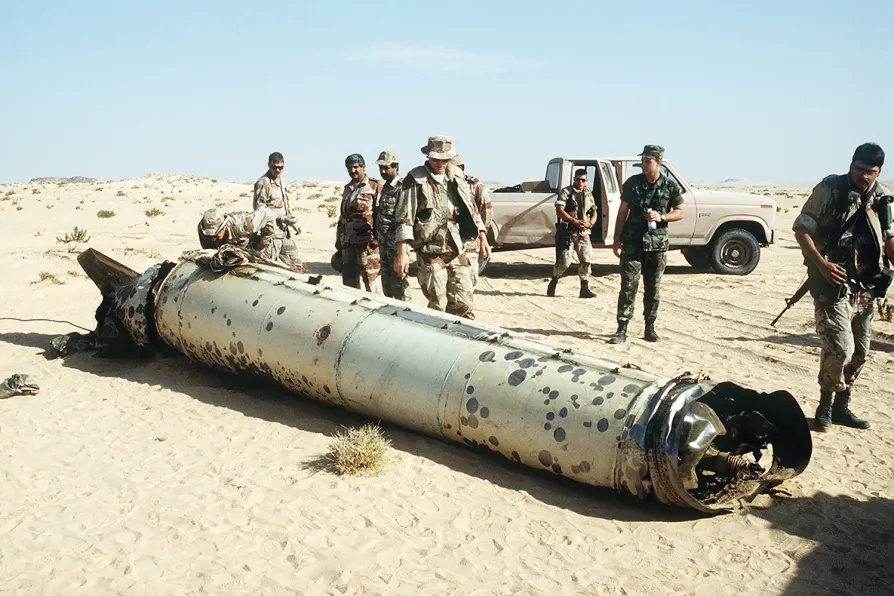From London’s holly-sellers to Engels’s flaming Christmas centrepiece, the plum pudding was more than festive fare in Victorian Britain, says KEITH FLETT
SOLOMON HUGHES highlights a 1995 Sunday Times story about the disappearance of ‘defecting Iraqi nuclear scientist.’ Even though the story was debunked, it was widely repeated across the mainstream press, creating the false – and deadly – narrative of Iraqi WMD that eventually led to war


THE “official” story is that fake news is spread by extremists or foreign governments to bamboozle us. Respectable newspapers and government officials will clear it up with “truth.”
But here is one of many examples showing the opposite. It is a small part of the Iraq weapons of mass destruction (WMD) deception, which involved many “mainstream” newspapers and politicians spreading fake news to promote war.
In 1995 the Sunday Times ran a story for three consecutive issues about “a defecting Iraqi nuclear scientist” who vanished in Greece “while trying to reveal details of the secret nuclear weapons programme that president Saddam Hussein has been hiding from United Nations inspectors.” The story suggested Saddam had the scientist abducted and probably murdered in Athens.
In 1995 the US and Britain wanted to keep sanctions on Iraq, claiming Iraqi leader Saddam was secretly developing nuclear weapons.
They wanted to persuade nuclear weapons inspectors of the International Atomic Energy Authority (IAEA) to rule that Saddam was still developing nukes. We now know Saddam was telling the truth and had abandoned his WMD programme. Unfortunately, it took a war in 2003 and hundreds of thousands of deaths to prove the WMD claims were lies.
One early clue that the WMD story was fake was that the 1995 Sunday Times story was completely false. The “scientist,” Khidir Hamza, had not been to Greece nor been kidnapped or killed there. He was still in Iraq and would escape to the West a few years later. The “documents” describing an active nuclear weapons programme were fake.
Unfortunately this fake news was not exposed back then, even though the newspapers and officials soon discovered it was untrue.
I have just received a response from the US State Department to a freedom of information request I made back in 2010 for information on the events.
It includes an April 1995 telex from the US embassy in London titled “British views on Iraqi defector,” which says “we discussed the disappearance of Iraqi dissident Khidir Abdul Abaz Hamza” with British Foreign Office (FCO) officials.
The telex says: “The official in the FCO’s non-proliferation department stated that no agency of the British government has been involved in any such operation. He added that the British were unable to find any record of Hamza … travelling to Greece.”
The telegram continues: “FCO’s Iraq desk officer said that the Sunday Times story, while plausible, appeared to lead to a dead end because important corroborating facts were not emerging. She understood that IAEA and USG [US government] officials were carrying out a more detailed examination of the documents, but there were some indicators that the documents might be forged or altered. Until more was known, it was best to say nothing publicly.”
So even in April 1995, the FCO knew the story was dubious. However, according to the telegram, “HMG [her majesty’s government] would, of course, prefer to believe the information contained in the faxes rather than the Iraqi denials.”
The FCO official “concluded by saying that, all things considered, the reports in the Sunday Times had been effective in sowing doubts within the IAEA about the Iraqi’s true nuclear intentions.”
The telex is signed “Crowe” — William J Crowe was then US ambassador to London.
So even though the FCO knew the story was dodgy, they were happy it put pressure on the IAEA. They just kept quiet about the dodgy elements.
In July 1995 the IAEA examined the supposed kidnapped scientists’ documents and concluded: “On the basis of all the evidence available, these documents are not authentic.” The names, titles and layout of the documents had obvious errors, and they were scientifically implausible.
The Sunday Times never reported that its high-profile story had been judged fake. Their original story was reported by dozens of US newspapers and the Independent in Britain. However, the IAEA declaration it was fake was barely reported in the West, and never connected back to the original report about Hamza.
Saddam’s son-in-law, General Hussein Kamal, who himself defected in 1995, also told the CIA Hamza was “useless” and “a professional liar.” But the fake news from 1995 remained unexposed.
This meant that Hamza was able to become the source for a whole new set of fake stories when the US and Britain started preparing for war over WMD six years later.
In a Times article in October 2001 under the headline “Saddam Must Go” Daniel Finkelstein told “the tale of Khidir Hamza” successfully building a “nuclear bomb” for Saddam. Only the fact it was “too big to attach to a missile” stopped it being launched at Israel.
In June 2002 historian Christopher Adams repeated this fake story about Hamza’s oversized nuclear bomb in the Times.
In August 2002, Hamza gave evidence before a Senate committee: the senators gave a platform for Hamza’s tall tales. The Financial Times, Evening Standard, Daily Mail, Daily Telegraph Sun, the Times and Sunday Times all reported the hearings without any scepticism. They reported Hamza was a “former director of Iraq’s nuclear weapons programme,” who told senators: “Iraq has enough uranium to produce three nuclear weapons by 2005.” This was false.
In September 2002 news got faker. The Times had a 1,400-word piece based on an interview with Hamza with claims Saddam could build nuclear weapons “within the next few months, if he has not already done so.” Hamza claimed the bomb factory was hidden from weapons inspectors “underground or in basements or buildings that outwardly seem normal.”
This fake story was then repeated by the Express, the Independent, the Evening Standard and the Daily Mail, without any scepticism.
The Sunday Mirror went further with a piece by Hamza himself. They claimed “Saddam’s top nuclear weapons scientist exclusively reveals” Iraq had material for “three nuclear devices.” The Mirror said Hamza revealed “an Iraqi intelligence team has taken delivery in Africa of spent fuel rods from a Russian nuclear reactor.” All of this was exclusive because it was imaginary.
All this fake news could have been stopped if the fake tale about Hamza and his documents had been exposed in 1995, but newspapers and government officials decided to keep quiet.
I should add as a coda that the Morning Star was one of the few newspapers standing up against Hamza’s fake news. In 2002 when Hamza gave his fake evidence to the US Senate, Felicity Arbuthnot accurately called Hamza a “controversial wild card” who had “variously been accused of having minimal knowledge of the nuclear industry and being paid handsomely by the CIA.”
Follow Solomon Hughes on X @solhugheswriter.
![SHAMELESS DISPLAY OF COERCION: Previously unreleased photos of Guantanamo captives, 2002, brought to Guantanamo Bay from Afghanistan by way of Incirlik, Turkey. [Pic: Staff Sergeant Jeremy Lock/CC]]( https://msd11.gn.apc.org/sites/default/files/styles/low_resolution/public/2025-11/cia%20web2.jpg.webp?itok=SyFt0Pzt)
GUILLERMO THOMAS enjoys a survey of the current state of the CIA (aka Langley) from an expert and insider of sorts

SOLOMON HUGHES explains how the PM is channelling the spirit of Reagan and Thatcher with a ‘two-tier’ nuclear deterrent, whose Greenham Common predecessor was eventually fought off by a bunch of ‘punks and crazies’

We are being dragged into not just a war, but a potentially nuclear war












